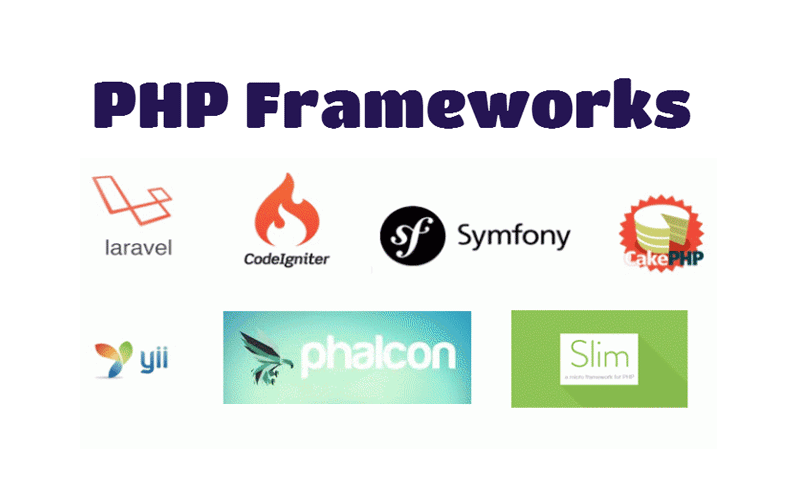Today, PHP is one most popular server-side scripting languages in the world that has evolved over a period of time which appeared first in static HTML files. Developers these days are tasked with building complex websites and applications. Hence, to avoid complexity and start from scratch at every instance, came a more structured and natural way of development in the form of PHP.
There are many reasons why developers use PHP frameworks which include: speed of development; well-organized and reusable code; high-level security for the website; follows MVC patterns; promotes modern web development practices; and frameworks that are scalable.
-
Laravel
Laravel is a new PHP framework which was released in 2011. According to the latest survey, it is one of the most popular PHP frameworks for web developers. This PHP framework has an enormous ecosystem with robust hosting and deployment platform. Moreover, their official website even offers screencast tutorials to help developers’ gain a better understanding of the framework.
Laravel has critical features that help in quick application development on a regular basis. The PHP framework has a lightweight templating engine known as ‘Blade’ which facilitates regular tasks such as authentication, RESTful routing, sessions, queuing, and more.
-
CodeIgniter
This CodeIgniter is one of the lightweight PHP frameworks that is a decade old and has a straightforward installation process which requires very minimal configuration and saving you from a lot of development troubles. Moreover, developers use this framework to avoid PHP version conflicts as it works on almost all dedicated hosting platforms.
This CodeIgniter framework is not completely based on MVC development pattern and using controller classes is a must. However, models and views are optional as you will be able to use your own coding and naming conventions. This is the reason why CodeIgniter is as popular with developers as it gives great freedom to them. Even if you download the framework, the size is only 2MB and hence it’s a lean framework, but will allow you to add other third-party plugins if you ever require complicated functionalities.
-
Symfony
Today, the Symfony PHP framework has a more ardent fan base and a wider community. There are many impressive projects that use Symfony 2 in the form of Drupal CMS and phpBB forum software. Even the Laravel PHP framework mentioned above also relies on Symfony.
The components used in this framework are reusable PHP libraries from which you can complete tasks such as object configuration, routing, authentication, templating, form creation, and more. Websites and applications developed with this framework have an interesting showcase section where you can have a sneak peek of the projects that developers have accomplished using this framework.
-
CakePHP
Released in 2005, CakePHP is not new anymore but still ranks among the best and most popular PHP frameworks, as it has always evolved and stayed relevant all these years. The latest version in CakePHP 3.0 has improved session management, modularity by decoupling several components, and ability to create more standalone libraries as its key features.
Some of the biggest brands like BMW, Express, and Hyundai uses CakePHP framework to power their websites and applications. This PHP framework is an amazing tool to create web applications that require high-level security. It has many security features like SQL injection prevention, XSS prevention, input validation, CSRF protection, and many more.
-
Slim
This is one such PHP framework that gives everything that a developer needs and nothing they do not. Slim is a PHP micro framework and has a minimalistic design which is excellent for small applications where full-stack version would be unrealistic.
Today, Slim is being used by many PHP developers to develop RESTful APIs and related services. Slim has all important features like session and cookie encryption; URL routing, client-side HTTP caching; and more. The user guide is in-depth and very easy to read.
-
Yii 2
Yii is one the faster PHP frameworks that are out there in the market, it certainly boosts your website’s performance as it uses the lazy loading technique. This PHP framework is purely object-oriented and is based on ‘Don’t Repeat Yourself’ concept of web development which gives a clean code base without any repetition.
Yii 2 has been integrated with jQuery and has few AJAX-enabled features. The framework also deploys easily usable skinning and theme mechanisms; it can be a great asset for someone who comes with a loaded frontend experience. The framework also has a powerful class code generator known as ‘Gii’ which facilitates rapid prototyping and object-oriented programming. Moreover, it provides you a web-based interface that enables you to interactively generate the code.
-
Phalcon
Phalcon PHP framework was released as early as 2012, a relatively new framework which gained widespread popularity among PHP developers. Phalcon framework is as fast as the falcon bird because it is written in C and C++ to give the best level of performance optimization. The best part here is that you do not have to read C language, as the functionality is there in the form of ready to use for any application.
Because Phalcon is delivered as C-extension, the architecture is optimized at low levels which help to reduce the overhead that is seen in MVC-based applications. The framework has great execution speeds and has decreased resource usage. It also has many features such as universal auto-loader, translation, caching, asset management, and more.
Conclusion:
These are some of the best PHP frameworks that are used by PHP developers across the globe. They offer tremendous benefits while developing robust websites and applications. Moreover, these PHP frameworks help beginners to become top-notch developers in their domain.


Great post, but Slim is micro framework. This is the reason why it is mostly used for creating Rest API. Also, if someone doesn’t have Linux skills, then it is best to use a managed PHP hosting, like Cloudways, where it is not necessary to manually setup the whole server, OS and stack.